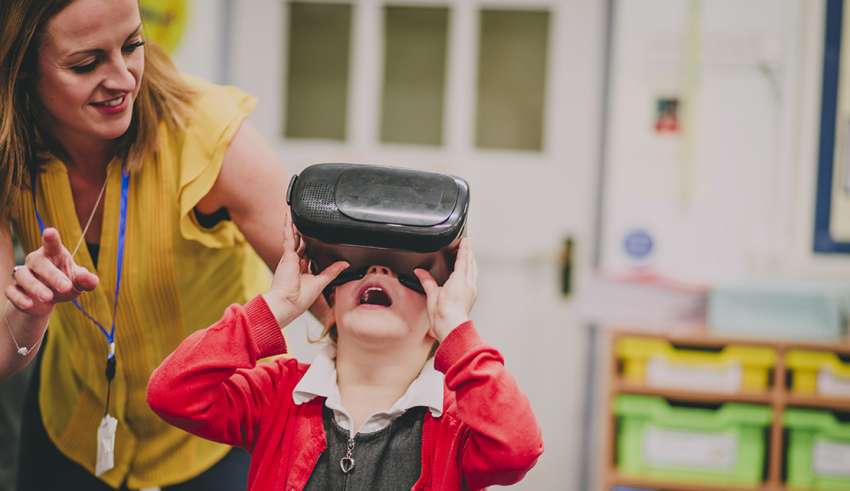
By 10Pearls
It is forecasted that education technology investment will reach $252 billion by next year according to a report from EdTechXGlobal. Tapping into the power of emerging technology is engaging students at all grade levels. These advances in technology are already transforming the educational system; a student can post homework to the school’s portal using a connected device, study French through an online class, learn physics through 3-D immersion and experience history through augmented reality.
The rise of educational technology is poised to solve many common challenges educational organizations, teachers, and students currently face. In this blog post, we’ll address technology’s ability to offer students with different socioeconomic backgrounds and learning styles equal opportunities to learn.
We’ve highlighted four emerging technologies that are leveling the educational playing field for both students and educators alike.
1. AI, Machine Learning, and Big Data
Scalable Solutions Schools Can Use to Give All Students Equal Opportunities
The reality of underfunding from K-12 to the university level makes full compliance to the Americans with Disabilities Act (ADA) nearly impossible for schools that barely have the basics like textbooks and computers. How can teachers give disabled students equal and fair educational experiences at scale?
Emerging technology can help educators empower all the students in their class, not just the majority. Artificial intelligence (AI) and big data can customize tools and generate solutions for improving the learning experience for the blind, deaf, and a-neurotypical students.
Translating voice to text might seem easy but replicating the nuances of human speech require incredibly advanced technology. Natural language processing (NLP) is a powerful subset of AI that levels the playing field for deaf students, the group that faces the largest obstacles to traditional lecture-style education. Similarly, screen readers read text aloud to help blind students consume course materials.
2. Personalized Digital Experiences
Student-Centric Teaching Accounts for All Learning Styles
Even though tests are standardized at every level of education from AP exams to the LSAT, not every student (or even adult, for that matter) learns the same. Resource constraints like limited funding prevent even the most creative and dedicated teachers from catering to each student individually.
Grading five different formats of the same assignment in the form of book reports, skits, and songs simply isn’t possible for many teachers due to the bandwidth they have available. Digital tools like mobile apps and online platforms bring the prospect of diversifying options for assessment much closer within reach. Emerging technologies and personalized digital experiences can deliver students specific content based on their learning style and level of knowledge.
In a recent Forbes article, Daniel Newman comments: “New digital transformation trends in technology are going to make it easier for students of different learning types to learn in the way most appropriate to them [such as] games, modeling tools, video production, etc.”
3. Augmented Reality/Virtual Reality and Mixed Reality
Elevate Engagement and Retention Levels with Immersive Educational Experiences
It’s no secret that public schools across the nation are often critically underfunded. Augmented reality (AR) and virtual reality (VR) can show school children a glimpse of exciting places they might never be able to afford to visit in real life.
At the university level and beyond, AR/VR and mixed reality can enhance the caliber of training students receive. Sophisticated tools can better prepare graduate students to succeed the first time around in high-stakes procedures, such as surgery for medical students.
Our recent post about how emerging technology enhances education shows an example of an AR visualization of a human skeleton. Bringing subjects like anatomy to life in an immersive and interactive format offers a more enriching learning experience.
4. Web Platforms with Mobile and IoT Connectivity
Digital Systems Keep Parents, Teachers, and Students on the Same Page
Web platforms and smartphones are a game-changer towards delivering and supporting learning. Connected systems help keep teachers and parents in the loop so they can provide more support and structure when needed.
Online systems also make teachers’ lives easier (i.e. grade papers faster, take attendance electronically, communicate with student more efficiently) especially when they connect with IoT devices like smartboards, iPads, and student IDs. Some schools aren’t quite there yet with “smart” devices, but more and more are harnessing the power of mobile apps by issuing students school-owned tablets like iPads.
Another benefit of mobile apps hosted on tablets is the free and easy way this technology can augment what students learn in the classroom with alternative opportunities beyond basic lectures and pop quizzes.
10Pearls has deep expertise in the education and education technology (edutech) industry where we work with both large established brands, as well as, start-ups helping them with innovation, acceleration and technology-enabled scaling. Unlike general software development contractors, 10Pearls provides strategic value with business process, user experience and design, digital strategy, and cybersecurity expertise.
We are currently helping an educational technology nonprofit with their digital transformation. This particular nonprofit focuses on closing the opportunity gap in education for underserved students and their families, specifically focusing on underserved students in 5th – 8th grades.
The nonprofit is growing rapidly, and their system is incapable of scaling. 10Pearls is modernizing their internal administrative system and developing a solution that includes a web platform, mobile component, and a built-in messaging system to ensure safety for children and to prevent abuse.
The paired mobile app features progress reports and educational resources parents can easily access online. The system accelerates operational efficiency while maintaining the high caliber of service the nonprofit provides, even in the face of rapid growth.
We also worked with a large education management organization (EMO) that provides online education for public school students in kindergarten through twelfth grade to help increase student engagement. We developed a dynamic online personalized learning platform for its students to learn, grow and explore. This comprehensive platform incorporates dynamic templates, workflows, and ADA considerations.
Emerging Tech is Key for Student Engagement
Millennials and the current generation of students have always been exposed to iPads, computers, and mobile devices. These devices have made life easier, more productive, and experiences more engaging. It only makes sense they would want and expect emerging technology in classroom learning. Immediate and unlimited access to information and learning tools is changing the face of education for the better.










